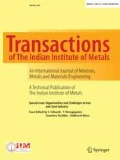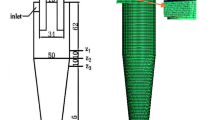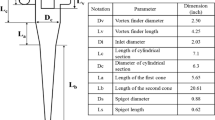Abstract
In spite of widespread applications of hydrocyclone, imprecise particle separation is an inherent limitation associated with it and led to a significant effect on the grinding operation. Such inefficiency is primarily attributable to the misplacement of significant amount of fine particles in the coarser product stream and commonly known as “bypass” in literature. Concerted research efforts are still continuing at various directions to rationalize the occurrence of such phenomenon in a quantifiable manner. This study reveals a fundamental basis towards the genesis and occurrence of bypass in hydrocyclone based on the hydrodynamic of particulate suspension within the turbulent field. Through a series of experiments, we generated carefully controlled experimental data in a 50.8 mm hydrocyclone to analyse the physical response of different parameters (design and operating) on the bypass. Proceeding with the experimental observations we disclose that fines recovery is not equal to that of water split in the underflow. Following this lead, we concluded that the bypass is principally driven by the hydrodynamic condition and the turbulent dispersion of the suspended particle in the prevailing centrifugal force field. Detailed calculations are presented on the basis of solid–fluid two-phase turbulent model to describe the above phenomenological incident. Although our analysis presented here confined to the small diameter hydrocyclone, we are optimistic that the acquired knowledge will be rationale towards the perception of a physical meaning to bypass even for larger classifying cyclones.












Similar content being viewed by others
Abbreviations
- d vf :
-
Vortex finder diameter (mm)
- d sp :
-
Spigot diameter (mm)
- d p :
-
Particle diameter (m)
- ρ s :
-
Particle density (kg/m3)
- ρ :
-
Fluid density (kg/m3)
- μ :
-
Fluid viscosity (kg/m3)
- P in :
-
Feed inlet pressure (kPa)
- Φ s :
-
Solid concentration (%w/w)
- s m :
-
Specific gravity of mixture
- u r :
-
Particle radial velocity (m/s)
- u θ :
-
Tangential velocity (m/s)
- u t :
-
Settling velocity (m/s)
- \( u^{*} \) :
-
Shear velocity (m/s)
- L dis :
-
Dispersion length scale (m)
- I dis :
-
Dispersion index (dimensionless)
- G :
-
G force (dimensionless)
- ω :
-
Centrifugal acceleration (m/s2)
- τ p :
-
Particle relation time (s)
- m wuf :
-
Mass of pulp water in underflow (kg)
- m wf :
-
Mass of pulp water in feed (kg)
- U :
-
Mass flow rates of solids in underflow (kg/s)
- F :
-
Mass flow rates of solids in feed (kg/s)
- u i :
-
Mass fraction of ith size particle in underflow
- f i :
-
Mass fraction of ith size particle in feed
- S :
-
Selectivity index
- C :
-
Classification function
- B p :
-
Bypass fraction
- R f :
-
Volumetric water recovery in underflow (dimensionless)
References
Banerjee C, Climent E, and Majumder A K, Chem Eng Sci 152 (2016) 724.
Knowles S R, Woods D R, and Feuerstein I A, Can J Chem Eng 51 (1973) 263.
Hsieh K T, and Rajamani R K, AIChE J 37 (1991) 735.
Fisher M J, and Flack R D, Exp Fluids 32 (2002) 302.
Lim E W C, Chen Y R, Wang C H, and Wu R M, Chem Eng Sci 65 (2010) 6415.
Dyakowski T, and Williams R A, Chem Eng Sci 48 (1993) 1143.
Brennan M, Chem Eng Res Des 84 (2006) 495.
Narasimha M, Brennan M, and Holtham P N, Int J Miner Process 80 (2006) 1.
Wang B, Chu K W, and Yu A B, Ind Eng Chem Res 46 (2007) 4695.
Wang B, and Yu A B, Chem Eng J 135 (2008) 33.
Ghodrat M, Kuang S B, Yu A B, Vince A, Barnett G D, and Barnett P J, Ind Eng Chem Res 52 (2013) 16019.
Banerjee C, Chaudhury K, Majumder A K, and Chakraborty S, Ind Eng Chem Res 54 (2015) 522.
Lynch A J, and Rao T C, in XI International Minerals Processing Congress, Cagliari (1975), p 9.
Plitt L R, CIM Bull (1976) 114.
Chen W, Zydek N, and Parma F, Chem Eng J 80 (2000) 295.
Coelho M A, and Medronho R, Chem Eng J 84 (2001) 7.
Nageswararao K, Wiseman D, and Napier-Munn T, Miner Eng 17 (2004) 671.
Narasimha M, Mainza A N, Holtham P N, Powell M S, and Brennan M S, Int J Miner Process 133 (2014) 1.
Wills B A, Mineral Processing Technology, Butterworth-Heinemann, Oxford (2006), p 188.
Kelsall D F, Trans Inst Chem Eng 30 (1952) 87.
Frachon M, and Cilliers J, Chem Eng J 73 (1999) 53.
Neesse T, Dueck J, and Minkov L, Miner Eng 17 (2004) 689.
Schubert H, Int J Miner Process 96 (2010) 14.
Endres E, Dueck J, and Neesse T, Miner Eng 31 (2012) 42.
Dueck J, Adv Powder Technol 24 (2013) 150.
Dueck J, Farghaly M, and Neesse T, Miner Eng 62 (2014) 25.
Nageswararao K, Powder Technol 297 (2016) 106.
Del Villar R, and Finch J A, Miner Eng 5 (1992) 661.
Roldan-Villasana E J, Williams R A, and Dyakowski T, Powder Technol 77 (1993) 243.
Kraipech W, Chen W, Parma F J, and Dyakowski T, Int J Miner Process 66 (2002) 49.
Bradly D, The Hydrocyclones, Pergamon Press, London (1965), p 57.
Bourgeois F, and Majumder A K, Powder Technol 237 (2013) 367.
Majumder A K, Yerriswamy P, and Barnwal J P, Miner Eng 16 (2003) 1005.
Kilavuz F S, and Gülsoy Ö Y, Int J Miner Process 98 (2011) 163.
Vallebuona G, Casali A, Ferrara G, Leal O, and Bevilacqua P, Miner Eng 8 (1995) 321.
Braun T, and Bohnet M, Chem Eng Technol 13 (1990) 15.
Dubey R K, Climent E, Banerjee C, and Majumder A K, Int J Miner Process 154 (2016) 41.
Shah H, Majumder A K, and Barnwal J P, Miner Eng 19 (2006) 102.
Banerjee C, Suresh, Majumder A K, and Varma S N, Int J Sci Res 2 (2013) 9.
Author information
Authors and Affiliations
Corresponding author
Rights and permissions
About this article
Cite this article
Banerjee, C., Dubey, R.K. & Majumder, A.K. Phenomenological Study on Fine Particle Misplacement Behavior in Hydrocyclone. Trans Indian Inst Met 70, 313–322 (2017). https://doi.org/10.1007/s12666-016-0993-6
Received:
Accepted:
Published:
Issue Date:
DOI: https://doi.org/10.1007/s12666-016-0993-6




